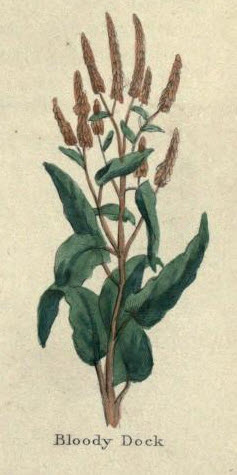
DOCK
Dock (blody dock) Herbal Remedies and Medicinal Uses of Dock:The red Dock is commonly called Bloodwort; it cleanses the blood, and strengthens the liver; but the yellow Dock root is best to be taken when either the blood or liver is affected by choler. It has a cooling drying quality. The seeds stay fluxes of all sorts, the loathing of the stomach through bile, and is good for those that spit blood. The roots boiled in vinegar remove itch, scabs, breaking out of the skin, if it be bathed therewith. The distilled water of the herb and roots have the same virtue. Blood-wort is very strengthening to the liver, and procures good blood, being as wholesome a pot-herb as any that grows in a garden. Hydrolapathum maximum. This is the largest of all Docks. It is much like the Sharp-pointed Dock, but much larger. It grows about waters, five or six feet high. In all respect, it is the same as the former, except its great size. Herbal Remedies and Medicinal Uses of Dock:Like the rest it is renowned for the cure of scurvy. So it was with the ancients; and it possesses great astringent qualities, and is good therefore for diarrhoea. In skin disorders it is a good remedy. In powder it is healing to old sores, ulcers, cleansing and healing them. The powdered root is a capital dentrifice for the teeth; removing scurvy from the gums As a tonic, to strengthen the stomach, ten or twelve grains will be sufficient. A decoction of it may be used for the same purpose. Take two ounces of the root sliced, to three pints of water, with a little cinnamon, or liquorice in powder, and boil down to a quart. A wine-glassful two or three times a day. Lapathum folio acute. A common plant, like the ordinary Dock, but handsomer, and distinguished by its sharp-pointed leaves, being narrower and longer. It grows three feet high. The stalks are erect, round, striated, green and branched. The leaves are of a fine green, smooth, with large ribs. Flowers, small, at first greenish, and when ripe, brown. The root is the part to be used. It is excellent for scurvy, and is one of the best herbs for sweetening or purifying the blood. It is best given in diet-drinks, and decoctions. Used externally, it is good for cutaneous eruptions, and for this purpose it should be beaten up with lard.
Important Disclaimer:
The information contained on this web site is for educational purposes
only. It is not intended to diagnose, treat, or cure any diseases. Any
information presented is not a substitute for professional medical advice
and should not take the place of any prescribed medication. Please do not
use this information to diagnose or treat a health problem or disease
without consultation with your physician.
This page and the rest of the encyclopedia of medicinal herbs was reproduced from old herbals written in the 1700 and 1800s. They are of historical interest to show the traditional uses of various herbs based on folk medicine and ancient wisdom. However the traditional uses for these herbs have not been confirmed by medical science and in some cases may actually be dangerous. Do not use the these herbs for any use, medicinal or otherwise, without first consulting a qualified doctor. Browse Herbs Alphabetically: A B C D E F G H I J K L M N O P Q R S T U V W X Y Z |
Advertisement
|
||
|
|||